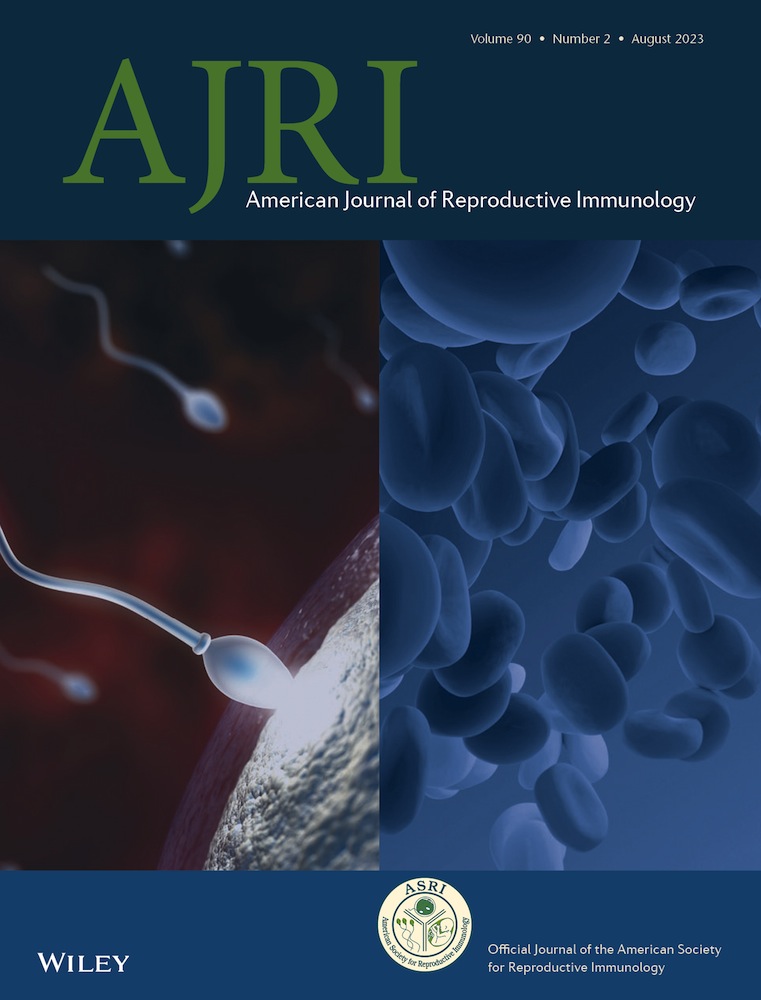The relationship of fetal sex and maternal race and ethnicity with early and late pregnancy C-reactive protein and interleukin-8
Anjali Jha, Noah Baumann, Scott T. Weiss, and Hooman Mirzakhani contributed equally to this work.
Abstract
Problem
Promotion of a healthy pregnancy is dependent on a coordinated immune response that minimizes inflammation at the maternal–fetal interface. Few studies investigated the effect of fetal sex on proinflammatory biomarkers during pregnancy and whether maternal race could impact this association. We aimed to examine whether fetal sex could, independently of maternal race/ethnicity and the condition of pregnancy (normal vs. complicated), impact inflammatory markers (C-reactive protein [CRP] and interleukin-8 [IL-8] levels) in early and late pregnancy.
Methods of study
This study was a cohort analysis using prospectively collected data from pregnant women who participated in the Vitamin Antenatal Asthma Reduction Trial (VDAART, N = 816). Maternal serum CRP and IL-8 levels were measured in early and late pregnancy (10–18 and 32–38 weeks of gestation, respectively). Five hundred and twenty-eight out of 816 pregnant women who participated in the trial had available CRP and IL-8 measurements at both study time points. We examined the association of fetal sex with early and late CRP and IL-8 levels and their paired sample difference. We further investigated whether maternal race/ethnicity, pregnancy complications (i.e., preeclampsia and gestational diabetes), and early pregnancy body mass index (BMI) could affect the association between these two biomarkers and fetal sex adjusting for potential confounders. For this purpose, we used generalized linear and logistic regression models on log-normalized early and late CRP and IL-8 levels as well as their split at median to form high and low groups.
Results
Women pregnant with male fetuses (266/528 = 56.5%) had higher CRP levels in early to mid-pregnancy (β = .18: 95% confidence interval [CI]: CI = 0.03–0.32; p = .02). Twenty-seven percent (143/528) of the study subjects were Hispanic. Hispanic African American [AA] women and women of races other than White and AA had higher levels of CRP at early to mid-pregnancy compared with White women (β = .57; 95% CI: 0.17–0.97; p < .01 and β = .27; 95% CI: 0.05–0.48; p = .02, respectively). IL-8 levels were not associated with fetal sex in early and late pregnancy (p’s > .05). Other factors such as gestational diabetes and early pregnancy BMI were associated with higher CRP levels and higher CRP and IL-8 levels, respectively. Dichotomizing log-normalized cytokine levels at the median in a sensitivity analysis, women with male fetuses had lower odds of high (above-median) IL-8 levels at early pregnancy. Also, women with races other than AA and White carrying male fetuses had higher odds of having high (above-median) late-pregnancy CRP and early-pregnancy IL-8 levels (adjusted odds ratio [aOR] = 3.80, 95% CI: 0.24–1.23; p = .02 and aOR = 3.57; 95% CI: 0.23–1.03; p = .02, respectively). Of the pregnancy complications, women with gestational diabetes mellitus had a higher paired difference of early and late pregnancy CRP levels (β = .38; 95% CI: 0.09–0.68; p = .01), but no difference in IL-8 levels (p’s > .05). No associations between the inflammatory markers and preeclampsia were found.
Conclusion
Fetal sex is associated with CRP in early pregnancy and an association with IL-8 in early pregnancy is implied. Our study further indicates that maternal race/ethnicity could be a contributing factor in the relationship between fetal sex and inflammatory responses during pregnancy. However, the specificity and level of the contribution might vary by type of cytokine, pregnancy stage, and other confounding factors such as BMI that may impact these associations.
CONFLICT OF INTEREST STATEMENT
The authors declare no conflict of interest.
Open Research
DATA AVAILABILITY STATEMENT
The data that support the findings of this study are available from the corresponding author upon reasonable request.




